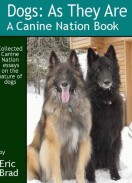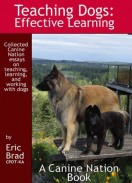 There is nothing I like more on long, lazy summer afternoons than to watch my dogs. Whether we are out at the park playing ball, enjoying a hike in the woods, or just lounging around the house, it always fascinates me to watch my dogs and the choices they make. Our dogs are our constant companions so it is understandable that one of the most overlooked (pun intended) aspects of being a good trainer is working on our powers of observation as we watch our dogs. It is easy to think that “watching the dog” is a simple and straightforward task – just look at the dog. But we can look at something and still not see it. I think it matters just how we watch our dogs.
There is nothing I like more on long, lazy summer afternoons than to watch my dogs. Whether we are out at the park playing ball, enjoying a hike in the woods, or just lounging around the house, it always fascinates me to watch my dogs and the choices they make. Our dogs are our constant companions so it is understandable that one of the most overlooked (pun intended) aspects of being a good trainer is working on our powers of observation as we watch our dogs. It is easy to think that “watching the dog” is a simple and straightforward task – just look at the dog. But we can look at something and still not see it. I think it matters just how we watch our dogs.
I can’t tell you the number of times that a friend has called and asked me what I was doing and I replied “Watching TV.” While that was technically true, if my friend had asked me what I was watching, my answer would usually entail the name of the show and maybe a few things about the plot. I probably couldn’t say what channel I was watching, the city in which the action is supposed to be taking place, or the names of more than 1 or 2 background characters. It’s possible that some or all of these details escaped my attention because I was checking my email on my tablet, getting snacks and drinks from the kitchen, and answering the phone while I was watching the TV. Clearly there are differing levels of attention to detail.
Finding focus
One of the first things I learned when I changed to science based training many years ago was that observation was a critical component to good training. More importantly, I discovered that observation skills can be practiced and improved. My understanding of the value of attentive observation came to me almost by accident. I tend to approach new learning in a systematic and methodical way. When I learned the basics of mark and reward training, I learned it as “clicker training” because it used a clicker as the marker signal. The mechanics were simple – see the behaviour you want, mark it with the click, and reward the dog with a food treat.
The books I was learning from (Don’t Shoot The Dog by Karen Pryor, The Culture Clash by Jean Donaldson, and others) and the online articles I was reading all emphasized the importance of timing in teaching the dog. The closer the marker was to the occurrence of the behaviour, the faster the dog is likely to learn. It seemed to me that in order to have good timing, I had to have good, focused observation to see the behaviour I was looking for; even a moment of distraction could cause me to miss my opportunity to reward my dog.
It was during this process of trying to improve my timing that something unexpected happened. I started noticing patterns of behaviour that weren’t related to what I was trying to teach. Sometimes my puppy would look uncomfortable and then wander off to sniff at something. Other times she would bounce at me and try to solicit play. And still other times she would pause and be still for several seconds before suddenly doing the behaviour I was teaching. It occurred to me that these seemingly unrelated behaviours could teach me something too.
Relationship is a two-way street
In his book “Animal Training – Successful Animal Management Through Positive Reinforcement”, animal trainer Ken Ramirez talks about the importance of observation to learn about the animal we are working with. Ramirez makes the point that we can learn about our dog’s preferences, moods, habits, and more in those unstructured moments when we are not getting the behaviour we are looking for. Play time or non-training time observations can be even more important in learning about our dogs likes and dislikes.
 Some trainers like to make this kind of observation a formal process, sometimes called an “ethogram”, and will keep a diary of their interactions and observations about their animals. I never went to that extreme but that early discovery about those interesting behaviour patterns in my puppy taught me what she looked like when she was confused, frustrated, or just thinking something out. As the weeks and months went on, I continued my observations even when we were not training and I learned a great deal about my dog.
Some trainers like to make this kind of observation a formal process, sometimes called an “ethogram”, and will keep a diary of their interactions and observations about their animals. I never went to that extreme but that early discovery about those interesting behaviour patterns in my puppy taught me what she looked like when she was confused, frustrated, or just thinking something out. As the weeks and months went on, I continued my observations even when we were not training and I learned a great deal about my dog.
Learning about my dog’s preferences has impacted my training in some important ways. It has helped me structure training sessions to fit her attention span, helped me to find new rewards to reinforce her behaviour, and, perhaps most importantly, to recognize when she was having a health problem and needed attention. Inevitably this led, as Ramirez suggests in his book, to a trust between trainer and dog. Not just because I could recognize her behaviours but because my dog learned that I would respond to her behaviours in a helpful or beneficial way.
Dog spying
It seems that most dog owners watch their dogs just enough to catch them doing something wrong. Before we changed the way we train, this was the way we watched our dogs. So long as our dogs weren’t doing anything we disapproved of, we kind of put them in the background. We knew they were there but unless they misbehaved, there was no reason to interact with them. To be honest, this was perfectly consistent with the way we used to train; a method I call “test and punish” – if they are doing something wrong, they fail the test and receive the punishment.
When I was new to science based training, I was part of an online discussion group that was looking for a slogan for the kind of training we all enjoyed. The accepted suggestion at the time was “Catch Your Dog Doing Something Right.” That slogan hit home with me precisely because it seemed to be the exact opposite of how I used to watch my dogs. Instead of trying to catch them in some misbehaviour, what if I caught them doing something I liked and rewarded that instead? Such a simple idea with such incredibly powerful impact on my life with my dogs!
So in addition to learning about my dog’s preferences and learning to read her moods, I was also learning to use life-situations as impromptu training opportunities. And the results were pretty terrific. Our dogs have learned to sit after their dinner so we can pick up their bowls without fuss. They have learned to stop barking at the door when we say “Thank you!” And lots of other little behaviours that we discovered and then put on cue to everyone’s benefit.
The more you look the more you see
When it comes to teaching our dogs, timing can be the difference between getting a reward and getting frustrated. It can be the gateway to understanding or it can lead to confusion and disinterest. Fortunately, observation and timing are things we can practice and improve on. And luckily for us, our dogs are remarkably forgiving of our mistakes so long as we are pretty good most of the time. They don’t expect perfection.
 But learning to be a good observer takes some thought and focus. We have to be willing to admit what we are seeing and not just recognize the things we want to see. Back in the days when we were trying to catch our dogs misbehaving, they were doing all kinds of behaviours we liked and wanted from them but we didn’t acknowledge them even if we did happen to notice that they were being good. That kind of selective observation was one of the things that we had to un-learn before we could become better observers.
But learning to be a good observer takes some thought and focus. We have to be willing to admit what we are seeing and not just recognize the things we want to see. Back in the days when we were trying to catch our dogs misbehaving, they were doing all kinds of behaviours we liked and wanted from them but we didn’t acknowledge them even if we did happen to notice that they were being good. That kind of selective observation was one of the things that we had to un-learn before we could become better observers.
We had to learn to take an interest in behaviours from our dogs that didn’t have anything to do with what we wanted from them. How did they interact with other dogs? How fast did they eat? What did they do when the needed to go out to do their business? How did they solicit play or signal that they had had enough? All of these things informed how we lived and worked with our dogs. It has created a lifestyle for us that just makes things easy. And none of that would be possible if we hadn’t taken the time to look and really see who our dogs are.
So, take a look. The next time you are sitting with your dogs or they are wandering around the backyard, what do you notice about them? Do they usually do that? Does it make them happy? What if you interacted with them differently? Learning about your dog by watching them can be incredibly helpful as well as enlightening and fun. Give it a try. After all, seeing is believing!
Until next time, have fun with your dogs!
Be sure to check out our Canine Nation ebooks in the Canine Nation store and Dogwise. Join our conversation on Facebook in the Canine Nation Forum!
These Canine Nation ebooks are now available –
Photo credits –
Dog Play – copyright Jim’s Photos1 2009 from Flickr
Dog Run -copyright Karin Dalziel 2014 from Flickr
Watching -copyright Ron Kikuchi 2014 from Flickr





Please Share Your Thoughts - Leave A Comment!